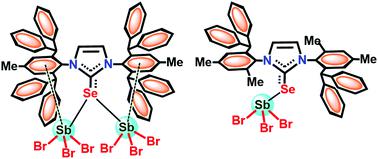当前位置:
X-MOL 学术
›
Dalton Trans.
›
论文详情
Our official English website, www.x-mol.net, welcomes your
feedback! (Note: you will need to create a separate account there.)
Rare antimony(III) imidazole selone complexes: steric controlled structural and bonding aspects
Dalton Transactions ( IF 3.5 ) Pub Date : 2020-10-30 , DOI: 10.1039/d0dt02999h Muneshwar Nandeshwar 1, 2, 3 , Mannem Adinarayana 1, 2, 3 , Katam Srinivas 1, 2, 3 , Kavitha Velappan 2, 3, 4 , Ganesan Prabusankar 1, 2, 3
Dalton Transactions ( IF 3.5 ) Pub Date : 2020-10-30 , DOI: 10.1039/d0dt02999h Muneshwar Nandeshwar 1, 2, 3 , Mannem Adinarayana 1, 2, 3 , Katam Srinivas 1, 2, 3 , Kavitha Velappan 2, 3, 4 , Ganesan Prabusankar 1, 2, 3
Affiliation

|
Novel antimony(III) imidazole selone complexes in a super crowded environment are reported for the first time. The super bulky selone antimony complexes, [{IPr*Se}(SbCl3)2] (1) and [{IPr*Se}(SbBr3)2] (2), were isolated from the reactions between IPr*Se (IPr*Se = [1,3-bis(2,6-diphenylmethylphenyl)imidazole selone]) and suitable antimony(III) halides. 1 and 2 are dinuclear complexes with a Sb : Se ratio of 1 : 0.5 with an unusual coordination mode of selone. The molecules 1 and 2 consist of both Menshutkin-type Sb⋯πaryl interactions and a Sb–Se coordination bond. However, the reaction between antimony(III) halides and [(IPaul)Se] ([(IPaul)Se] = [1,3-bis(2,4-methyl-6-diphenyl phenyl)imidazole selone]) with a spatially defined steric impact gave the dinuclear complex [{(IPaul)Se}(SbCl3)]2 (3) and the mononuclear complex [{(IPaul)Se}(SbBr3)] (4) without Menshutkin-type interactions. The Sb : Se ratio in 3 and 4 is 1 : 1. Interestingly, the Menshutkin-type interaction was absent in 3 and 4 due to the efficient coordinating ability of the ligand [(IPaul)Se] with the Sb(III) center compared to that of the super bulky ligand IPr*Se. The thermal property of these antimony selone complexes was also investigated. Density functional theory (DFT) calculations were carried out on the model systems [L(SbCl3)2] (1A), [L(SbCl3)] (1B), [L′(SbCl3)2] (1C), and [L′(SbCl3)] (1D), where L = [1,3-bis(2,6-diisopropyl-4-methyl phenyl)imidazole selone] and L′ = [1,3-bis(phenyl)imidazole selone], to understand the nature of orbitals and bonding situations. The computed metrical parameters of 1A are in good agreement with the experimental values. Natural population analysis of the model system reveals that the natural charge and total population of antimony(III) are comparable. The unequal interaction between selenium and antimony obtained using Wiberg bond indices (WBIs) is fully consistent with the findings of the single-crystal X-ray studies.
中文翻译:

稀有锑咪唑硒酮复合物:空间受控的结构和键合方面
首次报道了在超级拥挤环境中的新型锑(III)咪唑Selone复合物。从IPr * Se(IPr )之间的反应中分离出了超大体积的Selone锑配合物[{IPr * Se}(SbCl 3)2 ](1)和[{IPr * Se}(SbBr 3)2 ](2)。 * Se = [1,3-双(2,6-二苯基甲基苯基)咪唑Selone])和合适的卤化锑(III)。1和2是Sb:Se比率为1:0.5的双核配合物,具有非常规的selone配位模式。分子1和2均由Menshutkin型Sb⋯π组成芳基相互作用和Sb-Se配位键。但是,卤化锑( III)与[(IPaul)Se]([(IPaul)Se] = [1,3-双(2,4-甲基-6-二苯基苯基)咪唑selone])之间的反应定义的空间影响产生了没有Menshutkin型相互作用的双核复合物[{(IPaul)Se}(SbCl 3)] 2( 3)和单核复合物[{(IPaul)Se}(SbBr 3)]( 4)。3和4中Sb:Se的比率为1:1。有趣的是,由于配体[(IPaul)Se]与Sb()的有效配位能力,在3和4中不存在Menshutkin型相互作用。III)中心与超庞大配体IPr * Se的中心相比。这些锑selone配合物的热性能也进行了研究。在模型系统[ L(SbCl 3)2 ](1A),[ L(SbCl 3)](1B),[ L'(SbCl 3)2 ](1C)上进行密度泛函理论(DFT)计算,和[ L'(SbCl 3)](1D),其中L = [1,3-双(2,6-二异丙基-4-甲基苯基)咪唑selone]和L'= [1,3-双(苯基)咪唑Selone],以了解轨道的性质和键合情况。计算得出的1A的度量参数与实验值非常吻合。该模型系统的自然人口分析表明,自然充锑(总人口III)具有可比性。使用Wiberg键指数(WBI)获得的硒与锑之间的不均等相互作用与单晶X射线研究的结果完全一致。
更新日期:2020-11-18
中文翻译:

稀有锑咪唑硒酮复合物:空间受控的结构和键合方面
首次报道了在超级拥挤环境中的新型锑(III)咪唑Selone复合物。从IPr * Se(IPr )之间的反应中分离出了超大体积的Selone锑配合物[{IPr * Se}(SbCl 3)2 ](1)和[{IPr * Se}(SbBr 3)2 ](2)。 * Se = [1,3-双(2,6-二苯基甲基苯基)咪唑Selone])和合适的卤化锑(III)。1和2是Sb:Se比率为1:0.5的双核配合物,具有非常规的selone配位模式。分子1和2均由Menshutkin型Sb⋯π组成芳基相互作用和Sb-Se配位键。但是,卤化锑( III)与[(IPaul)Se]([(IPaul)Se] = [1,3-双(2,4-甲基-6-二苯基苯基)咪唑selone])之间的反应定义的空间影响产生了没有Menshutkin型相互作用的双核复合物[{(IPaul)Se}(SbCl 3)] 2( 3)和单核复合物[{(IPaul)Se}(SbBr 3)]( 4)。3和4中Sb:Se的比率为1:1。有趣的是,由于配体[(IPaul)Se]与Sb()的有效配位能力,在3和4中不存在Menshutkin型相互作用。III)中心与超庞大配体IPr * Se的中心相比。这些锑selone配合物的热性能也进行了研究。在模型系统[ L(SbCl 3)2 ](1A),[ L(SbCl 3)](1B),[ L'(SbCl 3)2 ](1C)上进行密度泛函理论(DFT)计算,和[ L'(SbCl 3)](1D),其中L = [1,3-双(2,6-二异丙基-4-甲基苯基)咪唑selone]和L'= [1,3-双(苯基)咪唑Selone],以了解轨道的性质和键合情况。计算得出的1A的度量参数与实验值非常吻合。该模型系统的自然人口分析表明,自然充锑(总人口III)具有可比性。使用Wiberg键指数(WBI)获得的硒与锑之间的不均等相互作用与单晶X射线研究的结果完全一致。











































 京公网安备 11010802027423号
京公网安备 11010802027423号